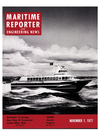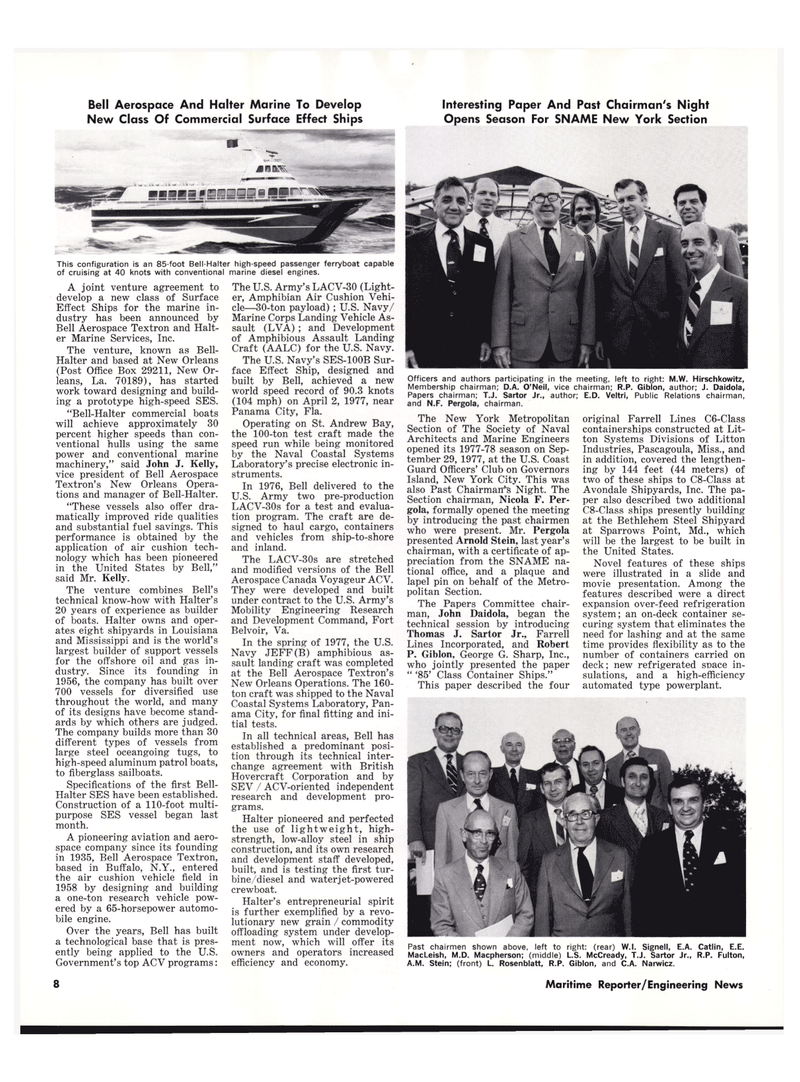
Page 6: of Maritime Reporter Magazine (November 1977)
Read this page in Pdf, Flash or Html5 edition of November 1977 Maritime Reporter Magazine
Interesting Paper And Past Chairman's Night
Opens Season For SNAME New York Section
This configuration is an 85-foot Bell-Halter high-speed passenger ferryboat capable of cruising at 40 knots with conventional marine diesel engines.
A joint venture agreement to develop a new class of Surface
Effect Ships for the marine in- dustry has been announced by
Bell Aerospace Textron and Halt- er Marine Services, Inc.
The venture, known as Bell-
Halter and based at New Orleans (Post Office Box 29211, New Or- leans, La. 70189), has started work toward designing and build- ing a prototype high-speed SES. "Bell-Halter commercial boats will achieve approximately 80 percent higher speeds than con- ventional hulls using the same power and conventional marine machinery," said John J. Kelly, vice president of Bell Aerospace
Textron's New Orleans Opera- tions and manager of Bell-Halter. "These vessels also offer dra- matically improved ride qualities and substantial fuel savings. This performance is obtained by the application of air cushion tech- nology which has been pioneered in the United States by Bell," said Mr. Kelly.
The venture combines Bell's technical know-how with Halter's 20 years of experience as builder of boats. Halter owns and oper- ates eight shipyards in Louisiana and Mississippi and is the world's largest builder of support vessels for the offshore oil and gas in- dustry. Since its founding in 1956, the company has built over 700 vessels for diversified use throughout the world, and many of its designs have become stand- ards by which others are judged.
The company builds more than 30 different types of vessels from large steel oceangoing tugs, to high-speed aluminum patrol boats, to fiberglass sailboats.
Specifications of the first Bell-
Halter SES have been established.
Construction of a 110-foot multi- purpose SES vessel began last month.
A pioneering aviation and aero- space company since its founding in 1935, Bell Aerospace Textron, based in Buffalo, N.Y., entered the air cushion vehicle field in 1958 by designing and building a one-ton research vehicle pow- ered by a 65-horsepower automo- bile engine.
Over the years, Bell has built a technological base that is pres- ently being applied to the U.S.
Government's top ACV programs:
The U.S. Army's LACV-30 (Light- er, Amphibian Air Cushion Vehi- cle—30-ton payload) ; U.S. Navy/
Marine Corps Landing Vehicle As- sault (LVA) ; and Development of Amphibious Assault Landing
Craft (AALC) for the U.S. Navy.
The U.S. Navy's SES-100B Sur- face Effect Ship, designed and built by Bell, achieved a new world speed record of 90.3 knots (104 mph) on April 2, 1977, near
Panama City, Fla.
Operating on St. Andrew Bay, the 100-ton test craft made the speed run while being monitored by the Naval Coastal Systems
Laboratory's precise electronic in- struments.
In 1976, Bell delivered to the
U.S. Army two pre-production
LACV-30s for a test and evalua- tion program. The craft are de- signed to haul cargo, containers and vehicles from ship-to-shore and inland.
The LACV-30s are stretched and modified versions of the Bell
Aerospace Canada Voyageur ACV.
They were developed and built under contract to the U.S. Army's
Mobility Engineering Research and Development Command, Fort
Belvoir, Va.
In the spring of 1977, the U.S.
Navy JEFF(B) amphibious as- sault landing craft was completed at the Bell Aerospace Textron's
New Orleans Operations. The 160- ton craft was shipped to the Naval
Coastal Systems Laboratory, Pan- ama City, for final fitting and ini- tial tests.
In all technical areas, Bell has established a predominant posi- tion through its technical inter- change agreement with British
Hovercraft Corporation and by
SEV / ACV-oriented independent research and development pro- grams.
Halter pioneered and perfected the use of lightweight, high- strength, low-alloy steel in ship construction, and its own research and development staff developed, built, and is testing the first tur- bine/diesel and waterjet-powered crewboat.
Halter's entrepreneurial spirit is further exemplified by a revo- lutionary new grain / commodity offloading system under develop- ment now, which will offer its owners and operators increased efficiency and economy.
Officers and authors participating in the meeting, left to right: M.W. Hirschkowitz,
Membership chairman; D.A. O'Neil, vice chairman; R.P. Giblon, author; J. Daidola,
Papers chairman; T.J. Sartor Jr., author; E.D. Veltri, Public Relations chairman, and N.F. Pergola, chairman.
The New York Metropolitan
Section of The Society of Naval
Architects and Marine Engineers opened its 1977-78 season on Sep- tember 29, 1977, at the U.S. Coast
Guard Officers' Club on Governors
Island, New York City. This was also Past Chairman's Night. The
Section chairman, Nicola F. Per- gola, formally opened the meeting by introducing the past chairmen who were present. Mr. Pergola presented Arnold Stein, last year's chairman, with a certificate of ap- preciation from the SNAME na- tional office, and a plaque and lapel pin on behalf of the Metro- politan Section.
The Papers Committee chair- man, John Daidola, began the technical session by introducing
Thomas J. Sartor Jr., Farrell
Lines Incorporated, and Robert
P. Giblon, George G. Sharp, Inc., who jointly presented the paper " '85' Class Container Ships."
This paper described the four original Farrell Lines C6-Class containerships constructed at Lit- ton Systems Divisions of Litton
Industries, Pascagoula, Miss., and in addition, covered the lengthen- ing by 144 feet (44 meters) of two of these ships to C8-Class at
Avondale Shipyards, Inc. The pa- per also described two additional
C8-Class ships presently building at the Bethlehem Steel Shipyard at Sparrows Point, Md., which will be the largest to be built in the United States.
Novel features of these ships were illustrated in a slide and movie presentation. Among the features described were a direct expansion over-feed refrigeration system; an on-deck container se- curing system that eliminates the need for lashing and at the same time provides flexibility as to the number of containers carried on deck; new refrigerated soace in- sulations, and a high-efficiency automated type powerplant.
Past chairmen shown above, left to right: (rear) W.I. Signell, E.A. Catlin, E.E.
MacLeish, M.D. Macpherson; (middle) L.S. McCready, T.J. Sartor Jr., R.P. Fulton,
A.M. Stein; (front) L. Rosenblatt, R.P. Giblon, and C.A. Narwicz. 8 Maritime Reporter/Engineering • News

 5
5

 7
7
